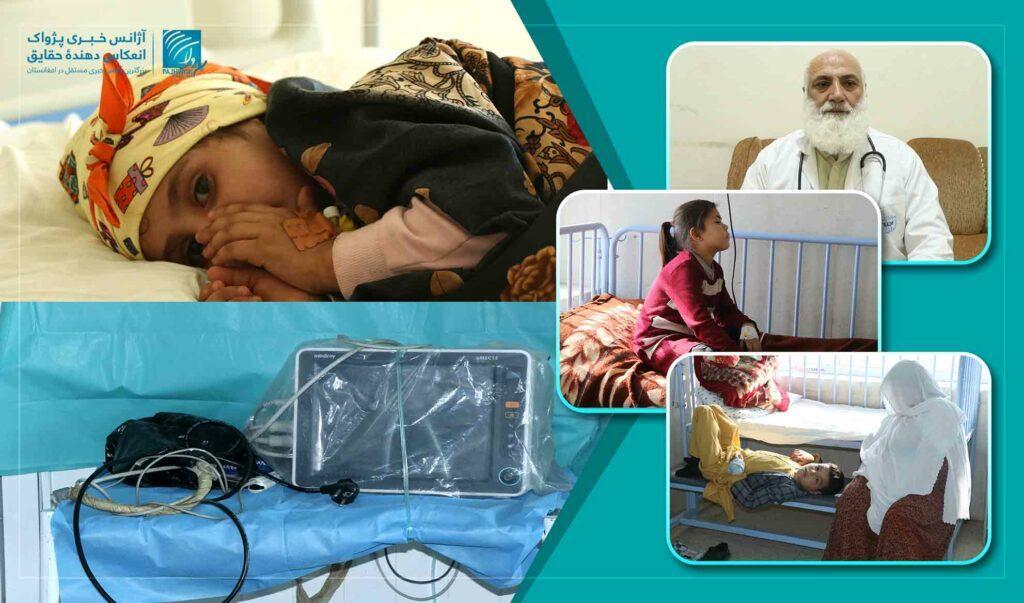
Doctors Warn Anemia In Children Serious, Urging Timely Treatment
KABUL (Pajhwok): A pediatric specialist has described anemia in children as a serious problem, warning that if not diagnosed and treated promptly, it can jeopardize all vital systems and organs.
The amount of blood in the human body varies depending on age, weight, and gender. An adult man weighing around 90 kg typically has about six liters of blood, a woman weighing around 74 kg has 4.3 liters, and a child weighing 453 grams has 70 to 75 milliliters of blood.
Dr. Mohammad Fayaz Safi, a specialist trainer at the Indira Gandhi Children's Health Hospital in Kabul, told Pajhwok Afghan News that while anemia can affect people of all ages, it is more common in children than in adults.
He explained that the symptoms of anemia in children may be mild and not immediately obvious, but common signs include pale skin, lips, and hands, cold extremities, yellowing of the skin, eyes, and mouth, heart palpitations, headaches, brittle nails, sores in the mouth and tongue, hair loss, and delayed growth.
Dr. Safi noted that anemia has various causes. Some children are born with anemia due to improper nutrition during pregnancy, while others may develop it later in life.
He emphasized that anemia is the most prevalent condition in Afghanistan, primarily caused by inadequate nutrition. Based on his information, 25 percent of the patients at the hospital are children with anemia.
Dr. Safi added,“Out of about one to two thousand patients who visit this hospital daily, 250 children suffer from anemia.”
He stressed that anemia in children should be taken seriously, warning that if left untreated, blood levels may drop to half of the normal amount, leading to dysfunction of the heart, kidneys, and liver. If anemia persists long-term, it could even become life-threatening.
Dr. Safi emphasized the importance of proper nutrition, noting that different foods play a crucial role in blood production, with some foods contributing five percent, others 10 percent, and others up to 90 percent to blood formation.
He recommended,“A pregnant woman should eat five meals a day, with a variety of foods, ensuring that all nutrients supporting blood production are included.”
He also said that foods rich in fats, proteins, vitamins, minerals, and sugars, particularly iron, are essential for preventing anemia.
Dr. Safi stressed the importance of monitoring children's nutrition, recommending exclusive breastfeeding for the first six months and complementary foods along with breastfeeding for children aged six months to two and a half years.
A section of the“National Standard Treatment Guidelines,” prepared by Afghanistan's Ministry of Public Health, states that anemia in children is mainly caused by poor nutrition.
The guidelines recommend that to prevent anemia, mothers should be properly nourished during pregnancy, and children should receive adequate nutrition during breastfeeding and childhood. They also suggest a diet rich in iron, meat, legumes, vegetables, and fruits.
Parents of children with anemia
Mohammad Zahir, a resident of Herat, whose five-year-old grandson is hospitalized at the Indira Gandhi Children's Health Hospital, said:“My grandson was hospitalized in Herat for the past 12 days and had blood transfusions three times, but it didn't help. So, we were advised to bring him here for better treatment.”
He explained that his grandson often suffers from nosebleeds, loss of appetite, and is always pale and fatigued.“Today, we brought blood from the blood bank for him. I pray for his betterment.”
Similarly, Abdul Mateen, a resident of Kabul, whose one-year-old daughter is hospitalized for anemia at the same hospital, said:“The doctors say my daughter is anemic and has a low blood count.”
Mateen, who is struggling with unemployment and economic difficulties, added:“I brought her once before for treatment, and she got better. But after some time, she developed anemia again.”
sa
Views: 2

Legal Disclaimer:
MENAFN provides the
information “as is” without warranty of any kind. We do not accept
any responsibility or liability for the accuracy, content, images,
videos, licenses, completeness, legality, or reliability of the information
contained in this article. If you have any complaints or copyright
issues related to this article, kindly contact the provider above.


















Comments
No comment